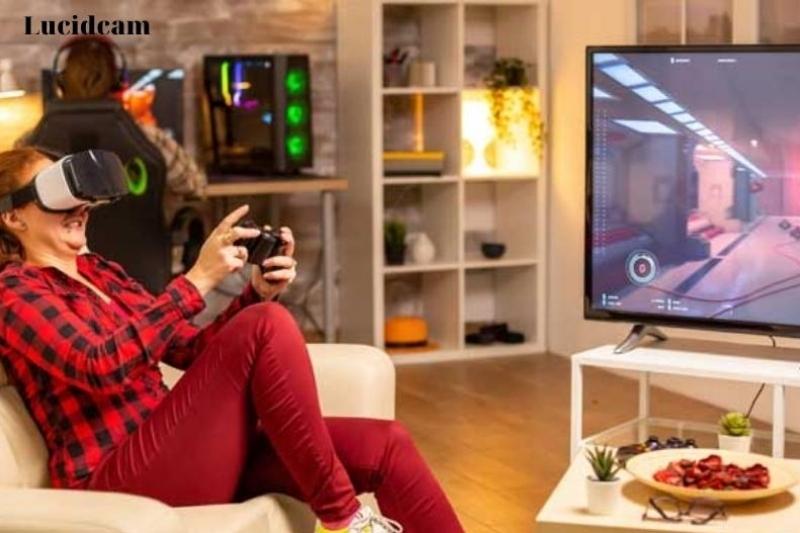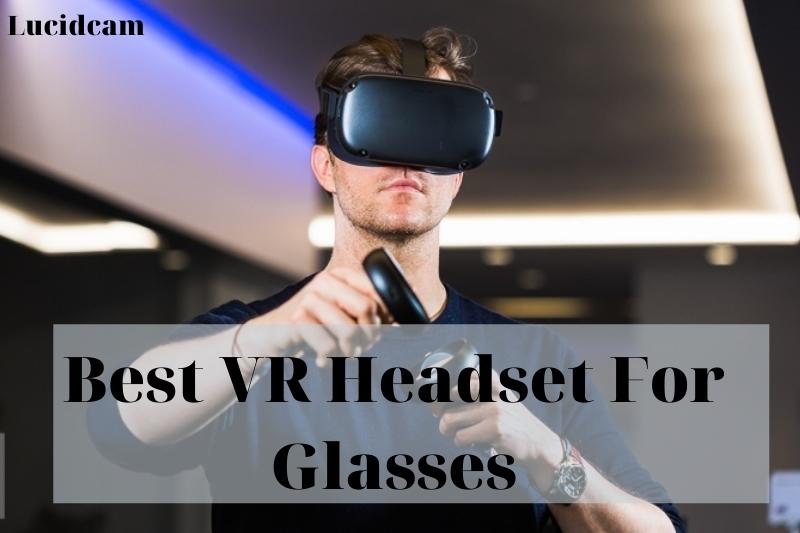If you need the top VR headset for glasses, we can help. Our latest VR headsets focus on your comfort. With many straps and sizes to adjust, you’ll find the right fit.
Many virtual reality headsets are available, but which is best for those wearing glasses? The answer depends on your wants and likes. Some headsets are made just for people with glasses, while others have optional prescription inserts. Here are seven best VR headsets for glasses we suggest.
Table of Contents
- 1 Top Rated Best VR Headset For Glasses
- 1.1 1. HTC Vive Cosmos Elite – The Best High-End, Roomy VR Headset For Media
- 1.2 2. Sony Playstation VR – Best Console Gaming Console
- 1.3 3. Oculus Quest 2, Best for People with Small Frames
- 1.4 4. HTC Vive Pro 2 – Best for High-Movement VR
- 1.5 5. Valve Index — Best for VR Afficianados
- 1.6 6. Pansonite VR Headset Best for Use with a Phone
- 1.7 7. HP Reverb G2
- 1.8 8. Samsung Gear VR
- 2 Tips For Playing VR With Glasses
- 3 What is a VR headset?
- 4 FAQs
- 5 Conclusion
Top Rated Best VR Headset For Glasses
1. HTC Vive Cosmos Elite – The Best High-End, Roomy VR Headset For Media
- 2880×1700 LCD Screen
- 90 Hz Refresh Rate
- Integrated Microphone
The HTC Vive Cosmos Elite says in its documentation that you can wear prescription glasses with it. To make the glasses more comfortable, they recommend that you raise the lenses. You should also ensure that your glasses don’t scratch the VR screen’s lenses.
This headset is high-end and requires an extensive setup. It is great for large areas when you are watching media or gaming. The flip-up design makes it easier to switch between normal reality and enclosed reality. This is especially important for those who wear glasses. It also means you should make sure your glasses fit securely on your face.
Some users reported difficulty getting the screen to work with glasses. While many have suggested using lenses, others claim they have been able to use the screen without any problems.
2. Sony Playstation VR – Best Console Gaming Console
- OLED Screen 1080p
- 90-120 Hz Refresh Rate
- Integrated Microphone
Pros:
- VR headset for comfort
- Respectable specs at a decent price
- PS4 console alternative
- Simple setup
Cons
- Steam games are not available to you
- Accessories are not included
The PSVR is a plug-and-play, high-end virtual reality system. It’s compatible only with the PlayStation console. While the debate over console or PC is still ongoing, it’s clear that owners of the PSVR headset agree that it is an amazing system for glasses-wearers.
The headset fits most faces comfortably and is very secure. The headset is light and comfortably fits your glasses and face. The interior is large and adjustable, so it can hold thick-set glasses frames. It is comfortable and has a 360-degree vision. The precision tracking system can also track the eye and body movements with pinpoint accuracy.
The PS VR headset experience is also amazing. It can’t play Steam-exclusive powerhouses, but it offers console owners a pleasant alternative if they don’t want to give up their Sony console.
The VR has an OLED display of 5.7 inches and 100-degree field-of-view vision. It is sufficient for most VR games, such as Microsoft Flight Simulator or Beat Sabers. The refresh rate is between 90 Hz and 120 Hz, which is a respectable range.
This display features a typical resolution of 1920×1080 pixels, common among many VR headsets. This is enough to allow you to spend a few hours immersed in a game, such as VR Chat or clicking your heads in a first-person shooter game.
The setup of the VR headset is much easier than with a more expensive VR system such as the HP Reverb G2. The main reason people choose this console is the ease of use if they already own a PS4.
You can’t play top-notch games on consoles without a high-quality graphics card or processor, which often creates a high entry barrier. However, with the PSVR, this issue doesn’t arise. The PSVR remains a leading VR console in virtual reality, even after five years.
This VR system’s affordability (from $400 to $600), makes it appealing to entry-level VR enthusiasts with glasses. You won’t have to worry about how your VR headset fits. It’s quite amazing.
3. Oculus Quest 2, Best for People with Small Frames
- LED Screen 1920×1832
- Refresh Rates up to 120 Hz
- Integrated Microphone
Pros:
- You won’t go bankrupt
- It is easy to set up
- Beginner-friendly
- For most glasses
Cons:
- Average stats
- Customizability at a low IPD
Oculus Quest 2 comes with an insert that can be used with glasses. You will need to take out the headset’s facial interface foam then place the spacer inside. The foam can then be reinstalled. This is a easy way to make your glasses more comfortable.
If you have glasses, it is best to put them on from the front. You can remove it by pulling it forward. The Oculus Quest2 headset has a very small space for many users.
Oculus is recommended to be used with glasses that measure 142 mm wide by 50 mm high. Before you buy this, make sure to check your glasses. Some people have had success with custom-made head straps that make the glasses larger or more comfortable.
4. HTC Vive Pro 2 – Best for High-Movement VR
- 2448×2448 LCD Display
- 120 Hz Refresh Rate
- Integrated Microphone
Pros:
- 120 Hz refresh rate
- High adaptability
- 4K graphics
- Comfortable for glasses wearers
Cons:
- You need a powerful PC setup
- The audio could be improved
The Vive is a VR headset that can both fit your glasses and allow you to move freely. Because of its design, it’s an active headset. The headset has a lot of space for you to move around in. Your glasses should be securely in the headset, so they don’t move when you do.
Most users who wear glasses say they have had a positive experience with the HTC Vive Pro 2. It can fit glasses up to 152mm in width and 60mm in height. This headset is very large and can be adjusted with the included head strap.
The Vive headset is slightly smaller than the Playstation VR headset. For people with larger heads, it could not be as comfortable.
5. Valve Index — Best for VR Afficianados
- 1440×1600 LCD Screen
- Refresh Rates up to 144 Hz
- Integrated Microphone
Pros:
- The incredible resolution, refresh rates, FOV
- Excellent external tracking
- The accessory that is compatible with glasses
Cons:
- This console will be overthrown by next-generation consoles
- It is more complicated than PSVR, etc.
- For the best gaming experience, you need a powerful rig
The Valve Index has received mixed reviews from users. It might not work well if you don’t play games that involve movement. It’s important to protect your lenses from movement and to adjust the fit of the lenses, so they don’t touch.
Aside from that, the Valve Index features plenty of room for glasses and, like most headsets, a dial for adjusting the lenses so you can see better. Overall, many people believe it is an excellent headset for use with glasses.
The Index has one problem. It is very expensive for all the parts it needs to function. If you’re uncertain whether it will accommodate your glasses, using the headset could prove challenging.
These specs are outstanding. Each eye has a display resolution of 1440x 1600 (2880×1660 combined). External sensors, SteamVR Tracking 2.0 external sensors, and a refresh rate up to 144Hz. This virtual reality machine was designed to provide comfort and high performance, and the luxury price reflects this.
6. Pansonite VR Headset Best for Use with a Phone
- No Screen
- Rely on your Phone
- No Microphone
A Pansonite VR headset is a low-tech way to enjoy media. Simply slip your phone in it and strap it on. Then, you can enjoy media in games in low-tech VR environments. These devices are suitable for glasses wearers.
An adjustable IPD can be used to move the screen towards or away from your face. This can make it easier to store your glasses or keep them safer. Remember that you are touching your phone with your glasses.
The screen of your phone is not part or the headset. This means that you shouldn’t move too much with it. If you’re interested in games involving extensive movement, this option could not be the best fit for you. Contact with your glasses or phone could cause damage.
7. HP Reverb G2
Pros:
- Display and audio quality are excellent
- Comfortable and light weight
- For most glasses
Cons:
- Comparing the average IPD to the competition
- Minimum PC requirements
- Sun-lit rooms can hinder tracking
The HP Reverb G2 is another great VR headset that you can strap onto glasses. The LCD screen is 2160×2160 resolution per eye and renders high-quality images. Although the refresh rate isn’t great, it’s still usable at a 90Hz refresh rate. The headset has a wide FOV of up to 114 degrees.
If your glasses are larger than 13.5 cm x 4. cm, the HP Reverb G2 may be too tight for you. If your glasses are narrower than 13.5 cm x 4cm, the HP Reverb G2 should not cause any issues with your gaming experience. You’ll enjoy a great gaming experience with the Reverb G2. It’s lightweight, easy to use, and comfortable.
The IPD of HP Reverb G2 can adjust from 60mm to 68mm. It’s a reasonable price for a device that costs $600. But it is not nearly as good as the HTC Vive 2’s IPD customization.
The HP Reverb G2 VR headset is a great choice if you want to experience an immersive auditory experience. This headset is a budget-friendly option compared to the Vive 2, and offers superior audio quality. However, if comfort is a priority, I’d suggest investing a bit more in the Vive.
8. Samsung Gear VR
Pros
- Very high quality, well-made controller
- Compatible with Galaxy S6, S7, and S8.
- High-detailed and crisp visuals with the Galaxy S8
- Innovative voice command
- Simple, clean interface
- Amazing head tracking
- Affordable
Cons
- Oculus’ mobile Gear VR software library contains your data
- You will need a Samsung phone
- Only a few apps support controllers.
- There is no place to store the controller
- The controller that is not rechargeable
- With the headset on, the phone looks “unfinished”.
- Incapable to track the movement of a room
- The Google Daydream View is larger and more expensive
The GearVR’s spacious interior and soft padding make it an ideal VR headset for glasses-wearers. The same brains behind Oculus Rift provide 360-degree immersion and a wide field of view. The 2017 model is different from previous years because it includes a hand-held controller. This makes navigation easier and opens up new possibilities for interactivity and gaming. The only downside to the Gear VR is that it requires a Samsung phone, so iPhone users are out of luck. The Gear VR is the best mobile VR headset and can be worn over glasses with ease.
Tips For Playing VR With Glasses

- It is a great idea to measure your glasses then compare them with the sizes of the different VR headsets. It is important to find a snug fit so your glasses won’t slip off your face or bounce around when you move fast. If you are able to find a place that offers demos, it is a good idea to try the glasses on before buying.
- I was able to test out various VR headsets at Microcenter and Best Buy. You can also ask your friends, or visit local gaming bars and shops, to see if they have VR rentals or rental options.
- You can find a spacer made specifically for your VR headset by third-party vendors if your spacer is uncomfortable or your glasses are too large. Even if your original headset doesn’t fit large glasses, an aftermarket spacer may be able to make your headset fit.
- You might consider purchasing VR screen protectors. Some people 3D-print their lens protectors. This will protect the VR screen from scratches.
- Before you put on the VR headset, make sure your lenses are clean. You might have a less clear view of the content and experience a poorer VR experience.
- Some users experience discomfort when their glasses press against their noses, causing pain. You can change to glasses, adjust the fit of your headset, or try a different pair if you feel this happens.
- You can make your glasses more comfortable by moving your glasses forward on your head a little from the temple tips.
- It doesn’t matter if your frames press down against the foam padding. It can often provide additional support. It’s important to check that it isn’t bending the frame.
- If your glasses are too big or uncomfortably large, prescription lens inserts may be available. They can be left in the VR headset, and you only use them for this activity.
- If you don’t have severe vision impairments, the VR headset can be used without glasses. People with a less severe prescription than -1.00 may be able to use the VR headset without glasses.
What is a VR headset?
Virtual reality headsets (VR headsets) are a headset that you wear on your head and above your eyes to create a virtual reality experience. VR headsets are also known as “VR glasses” and “VR goggles”.
VR headsets make use of a variety of technologies to detect what the wearer does and react to it in the virtual world. You can simply turn your head when wearing VR headsets to change the way you see things.
There are two types of VR headsets:
- They must be tethered to another device or computer.
- They are stand-alone and therefore cable-free
These are the most popular VR headsets for 2021:
- HTC Vive Cosmos (tethered).
- HTC Vive Pro 2 (tethered).
- Oculus Quest 2 (standalone)
- Sony PlayStation VR (tethered).
FAQs

1. Can you wear VR headsets with glasses?
While you can wear glasses with a VR headset, it is more difficult than wearing glasses without them. Make sure that your glasses are compatible with the VR headset you purchase. Before you put the headset on, make sure it fits snugly over your glasses.
2, Are glasses necessary for nearsighted people in VR?
3. Is VR a danger to the eyes?
Check out: Is VR Bad For Your Eyes And Brain 2023: Top Full Guide For You
4. How often should VR be stopped?
5. Which VR headset is compatible with glasses?
Oculus Rift is a great choice. Many VR headsets can be used with prescription glasses that have small or standard-sized frames and lenses. You may like the look of large glasses but want to use your VR headset with contact lenses and backup glasses.
Conclusion
In summary, picking the best VR headset for glasses might be tough, but there are many excellent choices on the market. When selecting a VR headset, consider aspects like comfort, glasses compatibility, resolution, and tracking features. The ideal VR headset for glasses will depend on your specific preferences and needs, but with the choices available now, enjoying immersive virtual reality experiences with glasses has never been simpler.
Last update on 2024-04-19 / Affiliate links / Images from Amazon Product Advertising API
